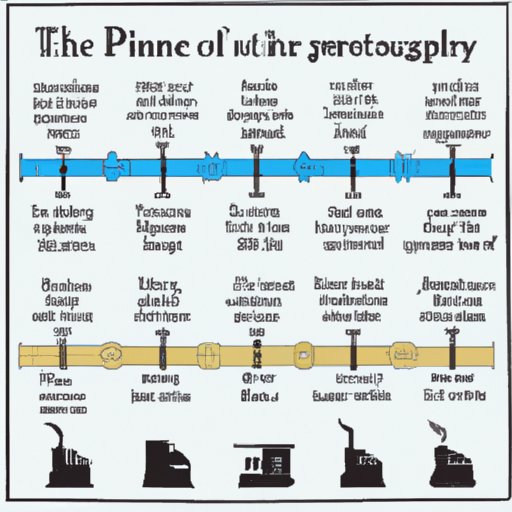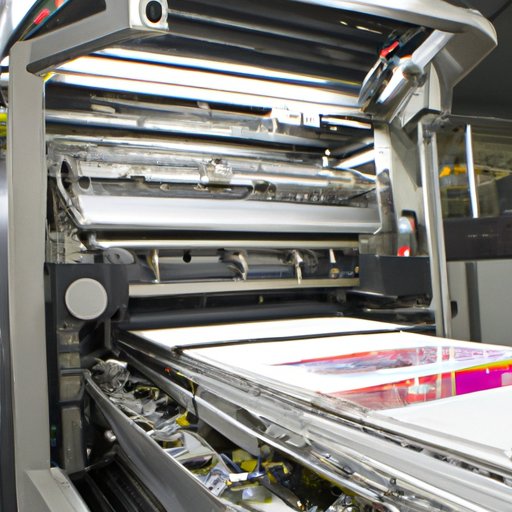Introduction
The printing press is a revolutionary invention that has shaped the world as we know it. From the time of its invention in the 15th century to today, this technology has impacted societies in numerous ways. This article will explore who invented the printing press, the timeline of its development, and the impact it has had on society.

Biography of Johannes Gutenberg and His Invention of the Printing Press
Johannes Gutenberg is credited with the invention of the printing press. He was born in Mainz, Germany in the year 1400. As a young man, he worked as a goldsmith and became skilled in the art of metalworking. He soon began experimenting with new ways to use this skill to create a printing device.
Gutenberg developed a movable type printing press that used individual pieces of metal type to form words and images. This was a significant improvement over earlier woodblock printing techniques, which required a separate block for each page. With his new device, Gutenberg was able to produce books much faster than ever before.
Gutenberg’s invention revolutionized the spread of information. For the first time, books and other printed materials could be mass-produced quickly and cheaply. This allowed knowledge to spread throughout Europe and beyond.

Timeline of the Development of the Printing Press
Before Gutenberg’s invention of the printing press, there were several pre-industrial printing technologies. The earliest known form of printing is woodblock printing, which dates back to the 3rd century CE in China. Woodblock printing was used to create prints and illustrations on paper.
Movable type printing was another pre-Gutenberg printing technology. It was first developed in 1041 in China and used individual pieces of type to form words and images. This technology was more efficient than woodblock printing but still relatively slow.
Gutenberg’s printing press combined the best elements of both woodblock printing and movable type printing. He used movable type to form words and images, but he also added a mechanical press that allowed him to print multiple copies of a single page at once. This made the process much faster and more efficient.
After Gutenberg’s invention, the printing press continued to evolve. In the 19th century, steam-powered presses allowed for even faster production of printed materials. The invention of lithography in the late 18th century opened up new possibilities for printing colorful images. In the 20th century, digital printing and 3D printing further revolutionized the industry.
Impact of the Printing Press on Society
The invention of the printing press had a profound impact on society. One of the most significant effects was the spread of information. Before the invention of the printing press, books and other printed materials had to be copied by hand, which was a slow and labor-intensive process. With the printing press, books and other documents could be mass-produced quickly and cheaply, allowing knowledge to spread more easily.
The invention of the printing press also led to an increase in literacy rates. Since printed materials were now more readily available, more people were able to access them and learn to read. This had a positive effect on education and allowed people to become more informed about the world around them.
The printing press also caused cultural changes. People were exposed to new ideas and perspectives, and this led to greater cultural exchange and understanding. The printing press also enabled the spread of religious texts, which helped to shape the beliefs of many cultures.
Analysis of the Technological Advancements That Enabled the Invention of the Printing Press
The invention of the printing press was made possible by several technological advancements. The first of these was the development of moveable type. This allowed letters and symbols to be arranged in any order, making it easier to print multiple copies of a single page.
The second technological advancement that enabled the invention of the printing press was the invention of the printing press itself. This allowed multiple pages to be printed quickly and efficiently. Finally, new ink formulas were developed that allowed for clearer and more vibrant images.
Comparison of Johannes Gutenberg’s Printing Press to Other Pre-Industrial Printing Technologies
Johannes Gutenberg’s printing press was a significant improvement over previous printing technologies. Woodblock printing was the first printing technology and was used to create prints and illustrations on paper. However, it was a slow and laborious process.
Movable type printing was another pre-Gutenberg printing technology. It was faster than woodblock printing but still relatively slow. Gutenberg’s printing press combined the best elements of both woodblock printing and movable type printing. His device used movable type to form words and images, but he also added a mechanical press that allowed him to print multiple copies of a single page at once.

Overview of the Printing Press in the 21st Century
Today, the printing press is used in a variety of ways. Digital printing is one of the most popular methods and is used to print photographs, magazines, and other documents. 3D printing is also becoming increasingly popular and is used to create objects from plastic, metal, and other materials.
Laser printing is another popular method that uses lasers to create high-quality images. Laser printers are often used in offices and can produce large volumes of printed material quickly and efficiently.
Conclusion
In conclusion, this article explored the history of Johannes Gutenberg and his invention of the printing press. It examined the technological advancements that enabled its creation and outlined the major impacts it had on society. Today, the printing press is still a vital part of our lives and continues to shape the way we communicate and exchange information.
(Note: Is this article not meeting your expectations? Do you have knowledge or insights to share? Unlock new opportunities and expand your reach by joining our authors team. Click Registration to join us and share your expertise with our readers.)
